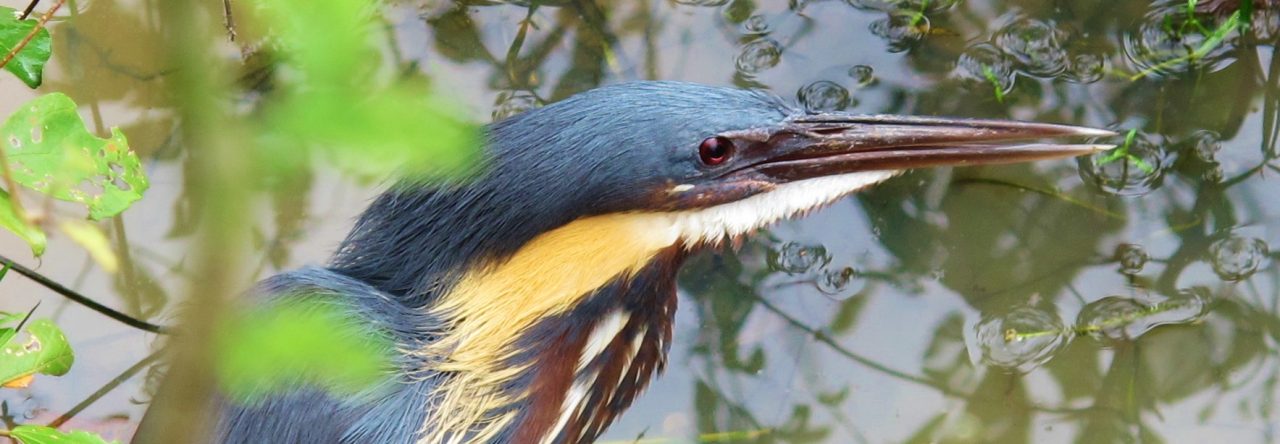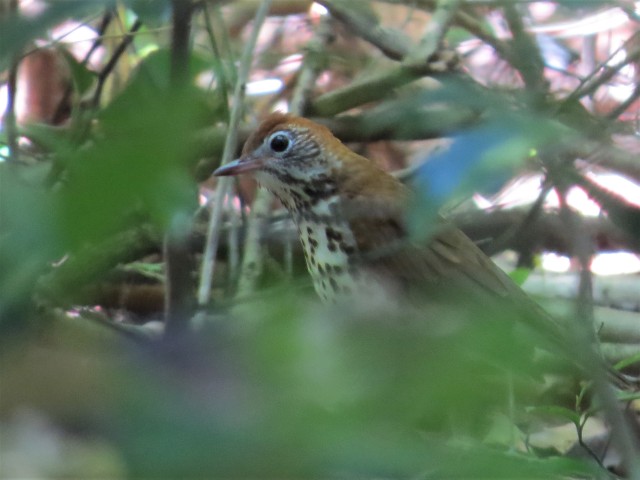
I am fortunate to live and work just a few minutes from one of urban Houston’s most productive migrant-watching locations, the Edith L Moore Nature Sanctuary, run by Houston Audubon. This small, mature woodland in the suburbs of west Houston is a renowned spot for migrant warblers in spring, as they pass through Texas in large numbers on the way to their breeding grounds.
The habitat is mostly dense, mature woodland, with a creek along most of the western edge. A handful of open areas – the parking lot, the plant nursery, and the main bridge over the creek – offer glimpses of sky, but mostly this is a spot for patient and quiet stalking through the woods while listening for bird calls. The lack of habitat diversity means it is unusual to see a long list of birds here, and entire families such as sparrows are either very scarce or entirely absent. Moreover, even the site specialties – warblers – are rarely present in large numbers. However, quality far exceeds quantity, and on a good day in spring, ten or more warbler species are possible.
The area around the cabin pond often attracts the widest variety of species, and well-stocked bird feeders cater for the resident birds and sometimes tempt migrants such as Indigo Bunting and Rose-breasted Grosbeak to linger for a few days. Elsewhere, birds are sparsely distributed throughout the woods. Migrant warblers often join the resident Carolina Chickadees in loose, mixed-species flocks, and tracking down the vocal chickadees is a useful technique when warbler-hunting here.
A handful of mulberry trees scattered throughout the reserve attract a range of birds when fruiting. The most obvious one is immediately adjacent to the cabin, above a small pond, and Baltimore Oriole, Rose-breasted Grosbeak and Gray Catbird – among other migrants – can be expected here in late April.
A sudden spring shower can produce a mini-fallout, especially in the taller trees around the cabin pond and along the creek, as tired birds take a break from their northbound migration to wait out the rain. Some of them hang around for a few hours, while others disappear immediately once the rain stops. Otherwise, it can be hard to predict when the reserve is going to be “hot”. A promising-looking weather front may produce almost nothing, while a clear day with light winds can unexpectedly bring in the birds. Migrants may drop in at any time of day, and in my experience late afternoon/evening visits are often the best.
This spring, I set myself an intention to visit the reserve at least five times a week between March 15th and May 15th. The data below summarizes all of my visits in the three months from March to May 2018, including a handful of visits made in early March and late May outside of the above-mentioned period. During these 13 weeks, I made 76 eBird checklists, an average of 5.84 visits per week. In peak migration season – mid to late April – I was at the reserve twice a day from Monday through Friday and occasionally at the weekend.
Edith L Moore Nature Sanctuary is well-covered in spring by numerous birders, but it is quite possible to see a very different range of migrants to someone else on site at the same time, such is nature of the densely vegetated habitat. In other words, it is easy to miss stuff here! The following 35 species were recorded by other birders during the spring, mostly only on a single occasion, but not by me:
Turkey Vulture
Bay-breasted Warbler
Yellow-throated Vireo
Swainson’s Hawk
Eurasian Collared-Dove
Dickcissel
Black-bellied Whistling-Duck
Willow Flycatcher
Lincoln’s Sparrow
Yellow Warbler
Orchard Oriole
Red-headed Woodpecker
Blue Grosbeak
Bronzed Cowbird
Cattle Egret
Philadelphia Vireo
Cerulean Warbler
Great Horned Owl
Savannah Sparrow
Yellow-bellied Sapsucker
Sharp-shinned Hawk
Eastern Towhee
Chipping Sparrow
Anhinga
Osprey
Yellow-throated Warbler
Cave Swallow
Cliff Swallow
Northern Rough-winged Swallow
Eastern Screech-Owl
Swallow-tailed Kite
Peregrine
White Ibis
Prothonotary Warbler
Merlin
I recorded a total of 96 bird species at E L Moore during the spring. The full species summary is below. “5/76 checklists” means I saw a species 5 times out of my 76 visits, and I have also included the maximum count for each bird:
Wood Duck: 3/76 checklists, max count 2. Perhaps tries to nest in tree holes along the creek, but infrequently seen.
Great Blue Heron: 3/76 checklists, max count 1. Sometimes seen along the creek.
Snowy Egret: 1/76 checklists, max count 1. Single bird at the creek under the main bridge in May.
Little Blue Heron: 3/76 checklists, max count 1. Single adult seen on a few occasions in late March and early April.
Green Heron: 1/76 checklists, max count 1. A single migrant along the creek in May was the only bird seen.
Black Vulture: 6/76 checklists, max count 2. Occasionally glimpsed soaring overhead.
Mississippi Kite: 6/76 checklists, max count 3. Breeds nearby, and sometimes wanders into reserve airspace from the end of April onwards.
Cooper’s Hawk: 5/76 checklists, max count 1. Occasional visitor.
Bald Eagle: 1/76 checklists, max count 1. Single adult soaring very high above the parking lot in late April. About the 6th or 7th record for the reserve.

Red-shouldered Hawk: 6/76 checklists, max count 2. Irregularly seen throughout the period.
Broad-winged Hawk: 1/76 checklists, max count 1. Single migrant over the parking lot in April.
Red-tailed Hawk: 12/76 checklists, max count 1. One locally resident individual sometimes seen over parking lot.
White-winged Dove: 73/76 checklists, max count 6. Common resident.
Mourning Dove: 12/76 checklists, max count 2. Presumably resident although much less common than White-winged.
Barred Owl: 7/76 checklists, max count 1. Pair resident on the reserve, although I only ever saw one at a time. Quite regularly seen in April and May on a favored perch above the stream viewed from bridge 4.
Common Nighthawk: 2/76 checklists, max count 3. Common breeder in Houston but infrequently noted on the reserve due to the lack of easily-viewable airspace.
Chuck-wills-widow: 4/76 checklists, max count 1. Most often seen only briefly when flushed. Probably a regular migrant through the reserve and no doubt more common than the small number of sightings would suggest.
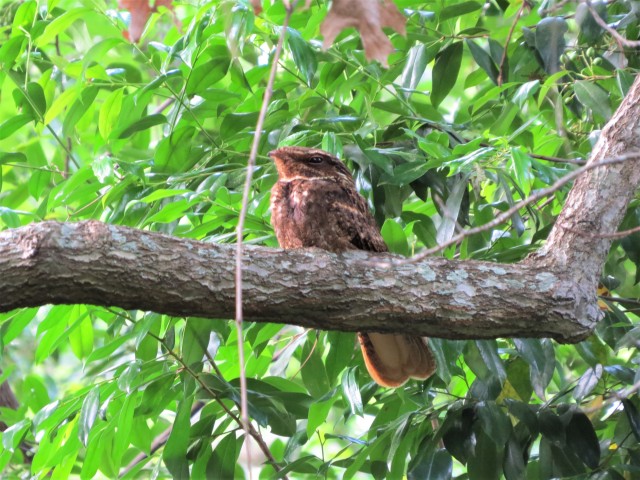
Chimney Swift: 43/76 checklists, max count 6. Regularly seen overhead.
Ruby-throated Hummingbird: 8/76 checklists, max count 2. When present, usually seen in trees around the parking lot, or visiting the feeder in front of the cabin.
Belted Kingfisher: 1/76 checklists, max count 1. Single bird along the creek in early April.
Red-bellied Woodpecker: 51/76 checklists, max count 3. Resident on the reserve.
Downy Woodpecker: 67/76 checklists, max count 8. Common resident.
Northern Flicker: 5/76 checklists, max count 2. Occasional visitor.
Pileated Woodpecker: 22/76 checklists, max count 2. Resident on the reserve.
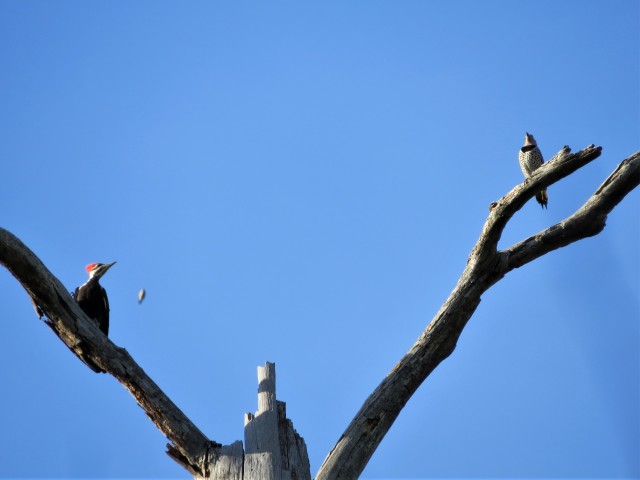
Olive-sided Flycatcher: 1/76 checklists, max count 1. Single migrant on the large dead Loblolly tree just outside the reserve’s western boundary in late May.
Eastern Wood-Pewee: 8/76 checklists, max count 3. Regularly seen from late April onwards, and perhaps breeds on the reserve.
Yellow-bellied Flycatcher: 1/76 checklists, max count 1. Single migrant in late May.
Acadian Flycatcher: 5/76 checklists, max count 2. The most regularly seen “empid” at E L Moore in April and early May.
Willow/Alder Flycatcher: 1/76 checklists, max count 1. Just a single non-calling bird by the oxbow in May.
Least Flycatcher: 2/76 checklists, max count 1. Singles in late April and early May, one beside the cabin and the other at the far south end of the reserve.
Eastern Phoebe: 1/76 checklists, max count 1. An occasional winterer, just the one bird seen during the period in early March.
Great Crested Flycatcher: 20/76 checklists, max count 3. Regularly seen and heard from mid-April onwards, and probably breeds on the reserve.
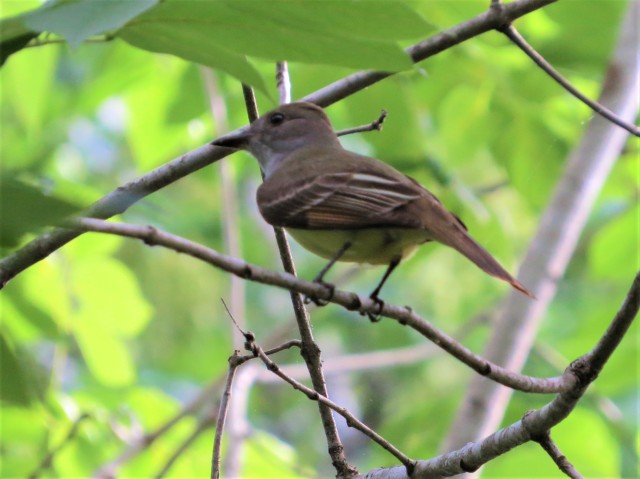
White-eyed Vireo: 10/76 checklists, max count 2. Occasional migrants throughout the period.
Blue-headed Vireo: 15/76 checklists, max count 3. Lingering winterers and spring migrants seen up to the end of April, often in song.
Warbling Vireo: 1/76 checklists, max count 1. A single migrant near the cabin in late April.
Red-eyed Vireo: 6/76 checklists, max count 2. Regular late season migrant, often in song.
Blue Jay: 75/76 checklists, max count 15. A common and vocal resident.
American Crow: 1/76 checklists, max count 1. Single bird in April.
Purple Martin: 14/76 checklists, max count 6. Migrants or local breeders sometimes seen overhead.
Tree Swallow: 5/76 checklists, max count 10. Migrants sometimes seen overhead.
Barn Swallow: 6/76 checklists, max count 1. The occasional migrant noted.
Carolina Chickadee: 70/76 checklists, max count 10. Common resident, highest numbers in May after young have fledged.
Tufted Titmouse: 22/76 checklists, max count 4. Resident breeder on the reserve.
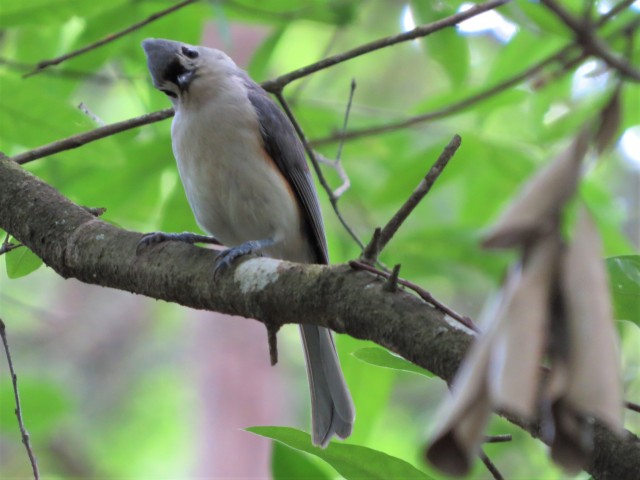
Carolina Wren: 64/76 checklists, max count 8. Common breeding resident.

Blue-gray Gnatcatcher: 24/76 checklists, max count 5. Winters on the reserve, and lingering birds/passage migrants regularly seen until mid April.
Ruby-crowned Kinglet: 46/76 checklists, max count 5. Winters on the reserve, and commonly seen until mid April, with a late bird in early May.
Veery: 3/76 checklists, max count 1. Three singles in April. Regular spring migrant in small numbers.
Gray-cheeked Thrush: 8/76 checklists, max count 3. Regular migrant, usually seen on the ground or at fruiting mulberry trees.
Swainson’s Thrush: 16/76 checklists, max count 8. Fairly common migrant in April and early May.
Hermit Thrush: 4/76 checklists, max count 1. Winters on the reserve, with the odd migrant still to be seen later in March and in April.
Wood Thrush: 39/76 checklists, max count 12. Common migrant and probable breeder on the reserve.
American Robin: 38/76 checklists, max count 4. Mainly a wintering bird, although several pairs breed on the reserve.
Gray Catbird: 16/76 checklists, max count 6. Fairly common migrant in April and May, usually seen in fruiting mulberry trees.
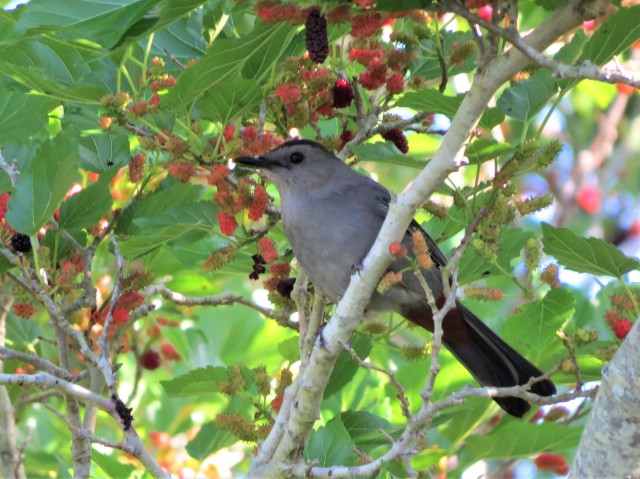
Brown Thrasher: 3/76 checklists, max count 1. Usually seen from the boardwalks at the back of the reserve. Status uncertain but perhaps overwinters and possibly even breeds.
Northern Mockingbird: 1/76 checklists, max count 1. Surprisingly rare, usually stays in gardens outside the reserve.
European Starling: 2/76 checklists, max count 3. The occasional flyover noted.
Cedar Waxwing: 9/76 checklists, max count 20. Wintering flocks linger until well into April.
Ovenbird: 14/76 checklists, max count 4. One of the specialties of the site which should always be present on a good migrant day in April and early May.
Worm-eating Warbler: 7/76 checklists, max count 1. Regularly encountered from late March.
Louisiana Waterthrush: 2/76 checklists, max count 2. A March and April migrant which should be looked for after rain at the Church Gate marsh, and the wet area in the south-east of the reserve.
Northern Waterthrush: 9/76 checklists, max count 5. The more frequent of the two waterthrushes, and tends to appear a little later than Louisiana.
Golden-winged Warbler: 5/76 checklists, max count 3. A local specialty of the site in late April and early May.
Blue-winged Warbler: 10/76 checklists, max count 2. Regularly seen from the end of March through early May.
Black-and-White Warbler: 12/76 checklists, max count 3. One of the more regular migrant warblers, seen throughout the season from March to May.
Swainson’s Warbler: 3/76 checklists, max count 1. It was a good spring at E L Moore for this unobtrusive species, with two birds in April and one in early May.
Tennessee Warbler: 6/76 checklists, max count 1. An occasional visitor on good migrant days, usually seen high in tall trees near the cabin or along the creek.
Orange-crowned Warbler: 9/76 checklists, max count 2. Winters commonly on the reserve but most birds depart in early March.
Nashville Warbler: 1/76 checklists, max count 1. An irregular spring migrant, apparently more common in fall.
Kentucky Warbler: 5/76 checklists, max count 2. A specialty of the site for those who put in the time and effort!

Common Yellowthroat: 5/76 checklists, max count 1. An occasional migrant at the Church Gate marsh or in bushes along the creek.
Hooded Warbler: 20/76 checklists, max count 3. One of the most regular migrant warblers, seen throughout the spring from March to May but especially earlier in the season.
American Redstart: 6/76 checklists, max count 4. Late season migrant which can be fairly numerous in early May.
Northern Parula: 8/76 checklists, max count 4. Regular migrant especially in April.
Magnolia Warbler: 8/76 checklists, max count 6. Not seen until May, when it is often the most numerous late season warbler.
Blackburnian Warbler: 2/76 checklists, max count 4. Stunning, sought-after migrant which is occasionally seen on the reserve especially in early May.
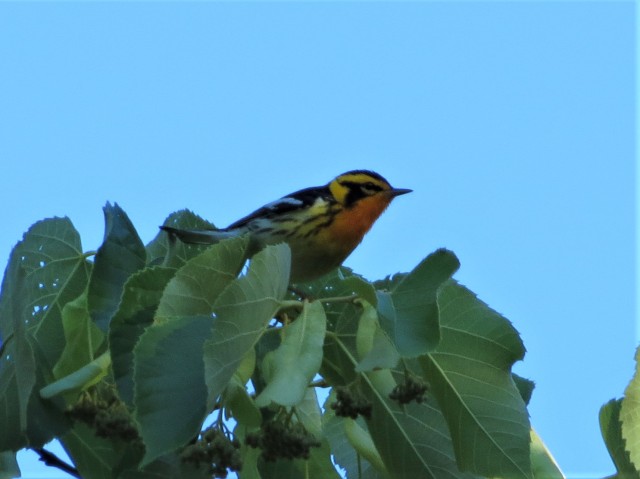
Chestnut-sided Warbler: 9/76 checklists, max count 3. Along with Magnolia, the most numerous of the late season migrants in early May.
Pine Warbler: 4/76 checklists, max count 1. Sometimes visits the cabin feeders in late winter, and singing birds in spring sometimes seen in mature pines at the far south of the reserve.
Yellow-rumped Warbler (Myrtle): 4/76 checklists, max count 3. Winters in small numbers on the reserve, but most birds leave early in March.
Black-throated Green Warbler: 3/76 checklists, max count 2. Occasional migrant.
Canada Warbler: 1/76 checklists, max count 1. Normally one of the more frequent and numerous late season warblers in May, for some reason this species was incredibly scarce this spring, with just one bird seen (a male in late April).
Wilson’s Warbler: 17/76 checklists, max count 3. Overwinters in small numbers on the reserve, with lingering birds/passage migrants throughout April, and a very late female calling and seen well in mid-May.
Yellow-breasted Chat: 5/76 checklists, max count 2. Regular migrant. Mulberry trees are a good place to look.
Summer Tanager: 5/76 checklists, max count 2. Regular migrant.

Scarlet Tanager: 2/76 checklists, max count 2. Seen in April in fruiting mulberry trees.
Northern Cardinal: 75/76 checklists, max count 18. Common breeding resident.
Rose-breasted Grosbeak: 9/76 checklists, max count 3. Regular migrant in late April, seen at the cabin feeders as well as on fruiting mulberry trees.

Indigo Bunting: 17/76 checklists, max count 15. An excellent spring for this species, with birds present at the cabin feeders – and elsewhere on the reserve – throughout most of April.
Painted Bunting: 4/76 checklists, max count 1, including a popular and much-admired male at the cabin feeders in April.
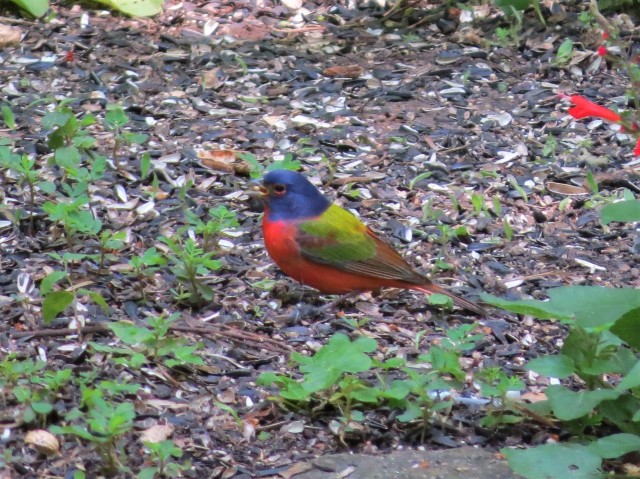
Baltimore Oriole: 2/76 checklists, max count 2. Several birds at the cabin mulberry tree in April.
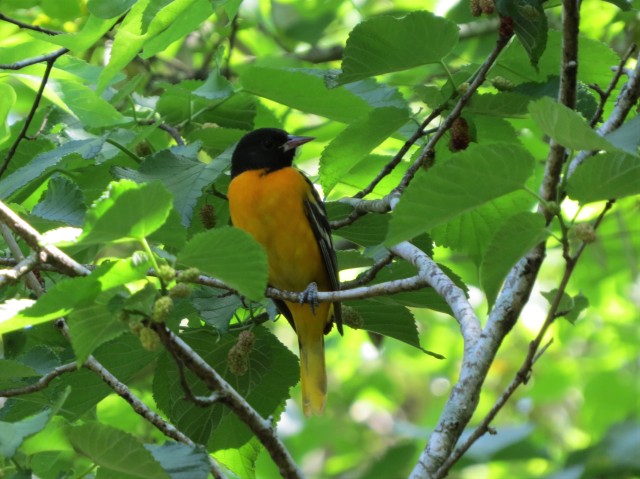
Red-winged Blackbird: 9/76 checklists, max count 3. Three wintering females at the cabin feeders in March dwindled to one by late April.
Common Grackle: 56/76 checklists, max count 50. Common resident/spring migrant. Surprisingly the only grackle seen on the reserve, although Great-tailed are resident nearby.
House Finch: 2/76 checklists, max count 2. A pair at the cabin feeders on one occasion in April, and a flyover bird.
American Goldfinch: 2/76 checklists, max count 1. A common wintering bird at the cabin feeders, but just one individual lingered into March.
House Sparrow: 5/76 checklists, max count 1. Singles occasionally at the cabin feeders.
